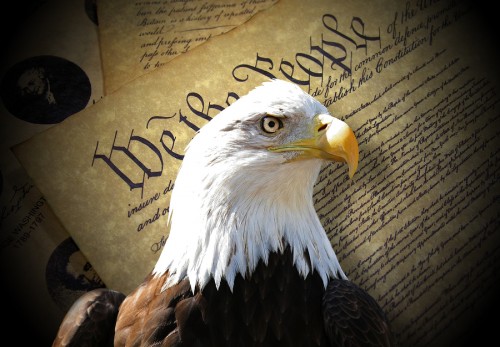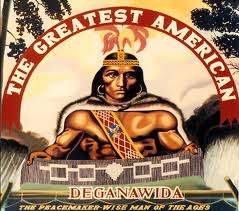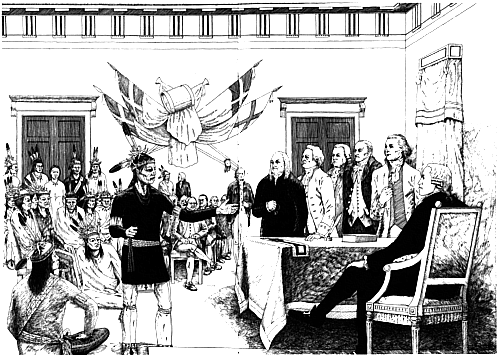The U.S. Constitution and the Great Law of Peace
 “The history of the U.S. Constitution we weren’t taught in school”, first published here in 2012, has turned out to be one of my most popular posts. I thought a repeat this holiday week would be appropriate.
“The history of the U.S. Constitution we weren’t taught in school”, first published here in 2012, has turned out to be one of my most popular posts. I thought a repeat this holiday week would be appropriate.
Only the title of the post has changed:
If you’re like me, I learned in grade school that the U.S. Constitution was based on ancient Greek democracy. Which was a creative stretch of the truth, since ancient Greece was not a democracy.
My research as to what children are taught today about the origin of our government is also disappointing, although there are some states that have updated the teachings to include Native American influence.
Apparently the Founding Fathers simply created it out of thin air, or were influenced by European governments even though there was no democracy anywhere in Europe at that time.
The True History of the U.S. Constitution
The truth is that the U.S. Constitution is modeled in both principle and form on the Great Law of Peace of the Native American tribe known as the Iroquois.
This is absolutely, unequivocally historical fact. While there may have been other influences, when compared side by side, the influence of the Great Law of Peace is irrefutable.
In 1987, the United States Senate acknowledged that the Great Law of Peace of the Iroquois Nations served as a model for the Constitution of the United States. (U.S. S. Con. Res. 76, 2 Dec. 1987).
And since the U.S. Constitution was a model for the charter of the United Nations, the Iroquois Great Law of Peace is also a basis of international law.
When the Founding Fathers looked for examples of effective government and human liberty upon which to model a Constitution to unite the thirteen colonies, they found it in the government of the Iroquois Nation.
In the 18th Century, the Iroquois League was the oldest, most highly evolved participatory democracy on Earth.
I find it sad that the true story is still not taught in all our schools [although some do]. But here it is:
The Peacemaker and the Great Law of Peace

The Peacemaker
In the 12th Century, five tribes in what is now the northeastern U.S. were constantly at war: the Mohawks, Seneca, Oneida, Onondaga and Cayugas. The wars were vicious and, according to tribal history, included cannibalism.
One day, a canoe made of white stone carried a man, born of a virgin, across Onondaga Lake to announce The Good News of Peace had come and the killing and violence would end.
He traveled from tribe to tribe over the course of years, preaching peace because peace was the desire of the Creator. Oral tribal history says it may have taken him 40 years to reach everyone and get agreement from all five tribes.
This man became known as The Peacemaker.
Eventually, the five tribes agreed to the Great Law of Peace and became known collectively as the Haudenosaunee, which means People of the Long House. Outsiders refer to them as Iroquois.
[In 1722, the Tuscarora joined the Confederacy so today it’s known as the Six Tribes of the Iroquois Confederacy].The Great Law of Peace was a vehicle for creating harmony, unity and respect among human beings.
Its recognition of individual liberty and justice surpasses that of many democracies.
The Great Law of Peace includes:
-
- freedom of speech,
- freedom of religion,
- the right of women to participate in government,
- separation of powers,
- checks and balances within government.
- a government “of the people, by the people and for the people,”
- three branches of government: two houses and a grand counsel,
- A Women’s Council, which is the Iroquois equivalent of our Supreme Court –settling disputes and judging legal violations.
The central idea underlying Iroquois political philosophy is that peace is the will of the Creator, and the ultimate spiritual goal and natural order among humans.
The Founding Fathers’ consultation with the Iroquois
 For decades, the Iroquois had urged the English colonists to unite together as one independent and free people.
For decades, the Iroquois had urged the English colonists to unite together as one independent and free people.
George Washington, Ben Franklin and Thomas Jefferson met frequently with the Iroquois and made themselves very familiar with the Great Law of Peace.
Washington expressed “great excitement” over the two houses and Grand Counsel.
Several delegates from the Iroquois Confederacy attended the Continental Congress in 1787 as it drafted the Constitution of the United States, modeling it on the Iroquois Constitution.
Three weeks later, it was signed, and the United States of America was born.
What got left out of the U.S. Constitution
In fact, just about the only parts of the Great Law of Peace that our founding fathers didn’t incorporate were these:
- The Seventh Generation principle: The Constitution of the Iroquois Confederacy states that chiefs consider the impact of their decisions on seven generations into the future.
- The role of women: Clan mothers choose candidates [who are male] as sachems [political leaders]. The women maintain ownership of land and homes, and exercise veto power over any council action that may result in war. The women can also impeach and expel any leader who conducts himself improperly or loses the confidence of the electorate; then the women choose a new leader.
Imagine how different our world would be today if our government had included these principles from the start
The symbols
The Peacemaker designated The Tree of Peace as a symbol of the Great Law of Peace — a great white pine tree whose branches spread out to shelter all nations who commit themselves to Peace.
- Beneath the tree the Five Nations buried their weapons of war.
- Atop the tree is the Eagle-that-sees-far.
- There is a bundle of five arrows tied together to represent strength of five tribes bound together in peace.
- Four long roots stretch out in the four sacred directions—the “white roots of peace.”
Thomas Jefferson adopted the symbols of the Peacemaker legend.
 The Tree of Peace became the Liberty Tree displayed on colonial flags.
The Tree of Peace became the Liberty Tree displayed on colonial flags.- Eagle-that-sees-far became the American Eagle, still a symbol of American government.
- On the U.S. Great Seal, the American Eagle clutches a bundle of thirteen arrows, representing the original colonies.
- Our eagle also holds an olive branch symbolizing that the United States of America has “a strong desire for peace, but will always be ready for war.”
Separate leaders for war and peace
There’s no separation of church and state in Iroquois society; spirituality lies at the root of government and law.
However, the Iroquois Confederacy, as with most tribes, had separate leaders for war and peace. As a lawmaker, the sachem could never go to war in his official capacity as sachem. If disposed to take the warpath, he laid aside his civil office for the time being, and became a common warrior.
The colonists followed this model, too. The inability to separate the civil government and military has doomed many imitators of American democracy, particularly in Africa and Latin America.
The three principles of the Great Law of Peace
1) Righteousness, meaning people must treat each other fairly. “Each individual must have a strong sense of justice, must treat people as equals and must enjoy equal protection under the Great Law.”
2) Health: “Health means that the soundness of mind, body and spirit will create a strong individual. Health is also the peacefulness that results when a strong mind uses its rational power to promote well-being between peoples, between nations.”
3) Power: “The laws of the Great Law provide authority, tradition and stability if properly respected in thought and action. Power comes from the united actions of the people operating under one law, with one mind, one heart, and one body. Such power can assure that justice and healthfulness continue. People and nations need to exercise just enough power to maintain the peace and well-being of the members of the Confederacy.”
It’s the omission of these three principles, the seven generations rule and the role of women that cause Native Americans today to say that, the United States Government copied the Great Law of Peace but didn’t really understand it.
So our forefathers copied the Great Law of a people whose land we stole and against whom our government committed genocide, and then kept it a secret for two hundred years.
It just makes me want to cry.
Please teach your children the truth of the history of our great country.
Sources for this post:
U.S. S. Con. Res. 76, 2 Dec. 1987.
https://americanindian.si.edu/sites/1/files/pdf/education/HaudenosauneeGuide.pdf
Chapter 8 in “Indian Givers; How the Indians of the Americas Transformed the World” by Jack Weathorford [Crown Publishers, 1988] and related bibliography.
Molly Larkin is the co-author of the international best-seller “The Wind Is My Mother; The Life and Teachings of a Native American Shaman” and other books on health. She is passionate about helping people live life to their fullest potential through her classes, healing practice and blog at www.MollyLarkin.com

